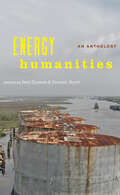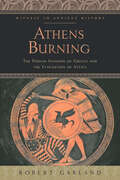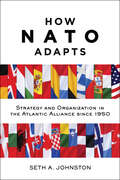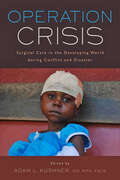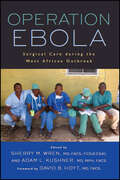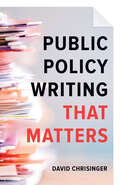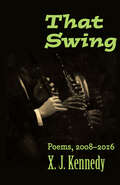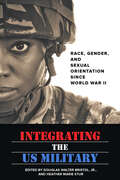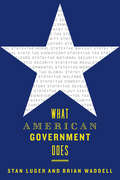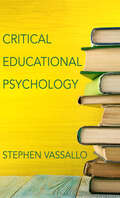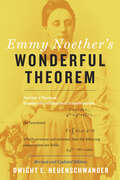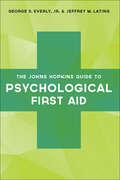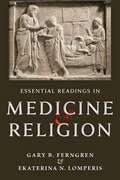- Table View
- List View
Energy Humanities: An Anthology
by Imre Szeman Dominic BoyerEnergy humanities is a field of scholarship that, like medical and digital humanities before it, aims to overcome traditional boundaries between the disciplines and between academic and applied research. Responding to growing public concern about anthropogenic climate change and the unsustainability of the fuels we use to power our modern society, energy humanists highlight the essential contribution that humanistic insights and methods can make to areas of analysis once thought best left to the natural sciences.In this groundbreaking anthology, Imre Szeman and Dominic Boyer have brought together a carefully curated selection of the best and most influential work in energy humanities. Arguing that today;€™s energy and environmental dilemmas are fundamentally problems of ethics, habits, imagination, values, institutions, belief, and power;¢;‚¬;€?all traditional areas of expertise of the humanities and humanistic social sciences;¢;‚¬;€?the essays and other pieces featured here demonstrate the scale and complexity of the issues the world faces. Their authors offer compelling possibilities for finding our way beyond our current energy dependencies toward a sustainable future.Contributors include: Margaret Atwood, Paolo Bacigalupi, Lesley Battler, Ursula Biemann, Dominic Boyer, Italo Calvino, Warren Cariou, Dipesh Chakrabarty, Una Chaudhuri, Claire Colebrook, Stephen Collis, Erik M. Conway, Amy De;€™Ath, Adam Dickinson, Fritz Ertl, Pope Francis, Amitav Ghosh, G;¶k;§e G;¼nel, Gabrielle Hecht, Cymene Howe, Dale Jamieson, Julia Kasdorf, Oliver Kellhammer, Stephanie LeMenager, Barry Lord, Graeme Macdonald, Joseph;‚ Masco, John McGrath, Martin McQuillan, Timothy Mitchell, Timothy Morton, Jean-Fran;§ois Mouhot, Abdul Rahman Munif, Judy Natal, Reza Negarestani, Pablo Neruda, David Nye, Naomi Oreskes, Andrew Pendakis, Karen Pinkus, Ken Saro-Wiwa, Hermann Scheer, Roy Scranton, Allan Stoekl, Imre Szeman, Laura Watts, Michael Watts, Jennifer Wenzel, Sheena Wilson, Patricia Yaeger, and Marina Zurkow
Energy Humanities: An Anthology
by Imre Szeman Dominic BoyerEnergy humanities is a field of scholarship that, like medical and digital humanities before it, aims to overcome traditional boundaries between the disciplines and between academic and applied research. Responding to growing public concern about anthropogenic climate change and the unsustainability of the fuels we use to power our modern society, energy humanists highlight the essential contribution that humanistic insights and methods can make to areas of analysis once thought best left to the natural sciences.In this groundbreaking anthology, Imre Szeman and Dominic Boyer have brought together a carefully curated selection of the best and most influential work in energy humanities. Arguing that today;€™s energy and environmental dilemmas are fundamentally problems of ethics, habits, imagination, values, institutions, belief, and power;¢;‚¬;€?all traditional areas of expertise of the humanities and humanistic social sciences;¢;‚¬;€?the essays and other pieces featured here demonstrate the scale and complexity of the issues the world faces. Their authors offer compelling possibilities for finding our way beyond our current energy dependencies toward a sustainable future.Contributors include: Margaret Atwood, Paolo Bacigalupi, Lesley Battler, Ursula Biemann, Dominic Boyer, Italo Calvino, Warren Cariou, Dipesh Chakrabarty, Una Chaudhuri, Claire Colebrook, Stephen Collis, Erik M. Conway, Amy De;€™Ath, Adam Dickinson, Fritz Ertl, Pope Francis, Amitav Ghosh, G;¶k;§e G;¼nel, Gabrielle Hecht, Cymene Howe, Dale Jamieson, Julia Kasdorf, Oliver Kellhammer, Stephanie LeMenager, Barry Lord, Graeme Macdonald, Joseph;‚ Masco, John McGrath, Martin McQuillan, Timothy Mitchell, Timothy Morton, Jean-Fran;§ois Mouhot, Abdul Rahman Munif, Judy Natal, Reza Negarestani, Pablo Neruda, David Nye, Naomi Oreskes, Andrew Pendakis, Karen Pinkus, Ken Saro-Wiwa, Hermann Scheer, Roy Scranton, Allan Stoekl, Imre Szeman, Laura Watts, Michael Watts, Jennifer Wenzel, Sheena Wilson, Patricia Yaeger, and Marina Zurkow
Athens Burning: The Persian Invasion of Greece and the Evacuation of Attica (Witness to Ancient History)
by Robert GarlandBetween June 480 and August 479 BC, tens of thousands of Athenians evacuated, following King Xerxes;€™ victory at the Battle of Thermopylae. Abandoning their homes and ancestral tombs in the wake of the invading Persian army, they sought refuge abroad. Women and children were sent to one safe haven, the elderly to another, while all men of military age were conscripted into the fleet. During this difficult year of exile, the city of Athens was set on fire not once, but twice. In Athens Burning, Robert Garland explores the reasons behind the decision to abandon Attica, the peninsular region of Greece that includes Athens, while analyzing the consequences, both material and psychological, of the resulting invasion.Garland introduces readers to the contextual background of the Greco-Persian wars, which include the famous Battle of Marathon. He describes the various stages of the invasion from both the Persian and Greek point of view and explores the siege of the Acropolis, the defeat of the Persians first by the allied Greek navy and later by the army, and, finally, the return of the Athenians to their land.Taking its inspiration from the sufferings of civilians, Athens Burning also works to dispel the image of the Persians as ruthless barbarians. Addressing questions that are largely ignored in other accounts of the conflict, including how the evacuation was organized and what kind of facilities were available to the refugees along the way, Garland demonstrates the relevance of ancient history to the contemporary world. This compelling story is especially resonant in a time when the news is filled with the suffering of nearly 5 million people driven by civil war from their homes in Syria. Aimed at students and scholars of ancient history, this highly accessible book will also fascinate anyone interested in the burgeoning fields of refugee and diaspora studies.
Athens Burning: The Persian Invasion of Greece and the Evacuation of Attica (Witness to Ancient History)
by Robert GarlandBetween June 480 and August 479 BC, tens of thousands of Athenians evacuated, following King Xerxes;€™ victory at the Battle of Thermopylae. Abandoning their homes and ancestral tombs in the wake of the invading Persian army, they sought refuge abroad. Women and children were sent to one safe haven, the elderly to another, while all men of military age were conscripted into the fleet. During this difficult year of exile, the city of Athens was set on fire not once, but twice. In Athens Burning, Robert Garland explores the reasons behind the decision to abandon Attica, the peninsular region of Greece that includes Athens, while analyzing the consequences, both material and psychological, of the resulting invasion.Garland introduces readers to the contextual background of the Greco-Persian wars, which include the famous Battle of Marathon. He describes the various stages of the invasion from both the Persian and Greek point of view and explores the siege of the Acropolis, the defeat of the Persians first by the allied Greek navy and later by the army, and, finally, the return of the Athenians to their land.Taking its inspiration from the sufferings of civilians, Athens Burning also works to dispel the image of the Persians as ruthless barbarians. Addressing questions that are largely ignored in other accounts of the conflict, including how the evacuation was organized and what kind of facilities were available to the refugees along the way, Garland demonstrates the relevance of ancient history to the contemporary world. This compelling story is especially resonant in a time when the news is filled with the suffering of nearly 5 million people driven by civil war from their homes in Syria. Aimed at students and scholars of ancient history, this highly accessible book will also fascinate anyone interested in the burgeoning fields of refugee and diaspora studies.
How NATO Adapts: Strategy and Organization in the Atlantic Alliance since 1950 (The Johns Hopkins University Studies in Historical and Political Science #132)
by Seth A. JohnstonToday;€™s North Atlantic Treaty Organization, with nearly thirty members and a global reach, differs strikingly from the alliance of twelve created in 1949 to "keep the Americans in, the Russians out, and the Germans down." These differences are not simply the result of the Cold War;€™s end, 9/11, or recent twenty-first-century developments but represent a more general pattern of adaptability first seen in the incorporation of Germany as a full member of the alliance in the early 1950s. Unlike other enduring post;€“World War II institutions that continue to reflect the international politics of their founding era, NATO stands out for the boldness and frequency of its transformations over the past seventy years.In this compelling book, Seth A. Johnston presents readers with a detailed examination of how NATO adapts. Nearly every aspect of NATO;¢;‚¬;€?including its missions, functional scope, size, and membership;¢;‚¬;€?is profoundly different than at the organization;€™s founding. Using a theoretical framework of "critical junctures" to explain changes in NATO;€™s organization and strategy throughout its history, Johnston argues that the alliance;€™s own bureaucratic actors played important and often overlooked roles in these adaptations. Touching on renewed confrontation between Russia and the West, which has reignited the debate about NATO;€™s relevance, as well as a quarter century of post;€“Cold War rapprochement and more than a decade of expeditionary effort in Afghanistan, How NATO Adapts explores how crises from Ukraine to Syria have again made NATO;€™s capacity for adaptation a defining aspect of European and international security. Students, scholars, and policy practitioners will find this a useful resource for understanding NATO, transatlantic relations, and security in Europe and North America, as well as theories about change in international institutions.
How NATO Adapts: Strategy and Organization in the Atlantic Alliance since 1950 (The Johns Hopkins University Studies in Historical and Political Science #132)
by Seth A. JohnstonToday;€™s North Atlantic Treaty Organization, with nearly thirty members and a global reach, differs strikingly from the alliance of twelve created in 1949 to "keep the Americans in, the Russians out, and the Germans down." These differences are not simply the result of the Cold War;€™s end, 9/11, or recent twenty-first-century developments but represent a more general pattern of adaptability first seen in the incorporation of Germany as a full member of the alliance in the early 1950s. Unlike other enduring post;€“World War II institutions that continue to reflect the international politics of their founding era, NATO stands out for the boldness and frequency of its transformations over the past seventy years.In this compelling book, Seth A. Johnston presents readers with a detailed examination of how NATO adapts. Nearly every aspect of NATO;¢;‚¬;€?including its missions, functional scope, size, and membership;¢;‚¬;€?is profoundly different than at the organization;€™s founding. Using a theoretical framework of "critical junctures" to explain changes in NATO;€™s organization and strategy throughout its history, Johnston argues that the alliance;€™s own bureaucratic actors played important and often overlooked roles in these adaptations. Touching on renewed confrontation between Russia and the West, which has reignited the debate about NATO;€™s relevance, as well as a quarter century of post;€“Cold War rapprochement and more than a decade of expeditionary effort in Afghanistan, How NATO Adapts explores how crises from Ukraine to Syria have again made NATO;€™s capacity for adaptation a defining aspect of European and international security. Students, scholars, and policy practitioners will find this a useful resource for understanding NATO, transatlantic relations, and security in Europe and North America, as well as theories about change in international institutions.
Operation Crisis: Surgical Care in the Developing World during Conflict and Disaster (Operation Health)
by Adam L. KushnerSurgical care is increasingly recognized as a critical component of global health, and strong surgical skills, teamwork, and poise under pressure become even more imperative during conflict or disaster. When faced with hospital bombings or devastating earthquakes, healthcare personnel must develop special techniques and abilities to ably care for patients despite limited resources and a disrupted health system. In Operation Crisis, Dr. Adam L. Kushner brings together 22 medical experts from around the world to recount their experiences in the field when disaster struck. These candid firsthand accounts from both local and international aid surgeons provide clinicians and public health practitioners with insightful lessons for effectively treating surgical patients under the most grueling of circumstances.Moving from conflict settings that include war zones in Afghanistan, the Democratic Republic of the Congo, Syria, and South Sudan, Operation Crisis also touches on post-earthquake Haiti and Nepal and post-tsunami Indonesia. Individual themed chapters cover mass casualty training, burn care, obstetric care, sexual violence, and landmine injuries. Combining personal stories with lessons learned and possible interventions, these vivid and affecting essays detail the immediate aftermath of conflict and disaster while pointing the way to improving care for future victims of crisis.Intended to spark further discussion and function as an advocacy tool while highlighting situations where surgical care can save lives and reduce disability, this book is a valuable resource for medical professionals, students, policy makers, international aid organizations, and philanthropic donors.Contributors: Kapendra Shekhar Amatya, Samer Attar, Jeffrey A. Bailey, Lucas C. Carlson, James C. Cobey, Dattesh R. Dave, Dan L. Deckelbaum, Richard A. Gosselin, Shailvi Gupta, Edna Adan Ismail, Thaim B. Kamara, T. Peter Kingham, Adam L. Kushner, Judy M. Lee, Maria "Tane" Pilar Luna, Brijesh Mishra, Kyle N. Remick, Lauri J. Romanzi, Michael Sinclair, Barclay T. Stewart, Marten van Wijhe, Evan G. Wong
Operation Crisis: Surgical Care in the Developing World during Conflict and Disaster (Operation Health)
by Adam L. KushnerSurgical care is increasingly recognized as a critical component of global health, and strong surgical skills, teamwork, and poise under pressure become even more imperative during conflict or disaster. When faced with hospital bombings or devastating earthquakes, healthcare personnel must develop special techniques and abilities to ably care for patients despite limited resources and a disrupted health system. In Operation Crisis, Dr. Adam L. Kushner brings together 22 medical experts from around the world to recount their experiences in the field when disaster struck. These candid firsthand accounts from both local and international aid surgeons provide clinicians and public health practitioners with insightful lessons for effectively treating surgical patients under the most grueling of circumstances.Moving from conflict settings that include war zones in Afghanistan, the Democratic Republic of the Congo, Syria, and South Sudan, Operation Crisis also touches on post-earthquake Haiti and Nepal and post-tsunami Indonesia. Individual themed chapters cover mass casualty training, burn care, obstetric care, sexual violence, and landmine injuries. Combining personal stories with lessons learned and possible interventions, these vivid and affecting essays detail the immediate aftermath of conflict and disaster while pointing the way to improving care for future victims of crisis.Intended to spark further discussion and function as an advocacy tool while highlighting situations where surgical care can save lives and reduce disability, this book is a valuable resource for medical professionals, students, policy makers, international aid organizations, and philanthropic donors.Contributors: Kapendra Shekhar Amatya, Samer Attar, Jeffrey A. Bailey, Lucas C. Carlson, James C. Cobey, Dattesh R. Dave, Dan L. Deckelbaum, Richard A. Gosselin, Shailvi Gupta, Edna Adan Ismail, Thaim B. Kamara, T. Peter Kingham, Adam L. Kushner, Judy M. Lee, Maria "Tane" Pilar Luna, Brijesh Mishra, Kyle N. Remick, Lauri J. Romanzi, Michael Sinclair, Barclay T. Stewart, Marten van Wijhe, Evan G. Wong
Operation Ebola: Surgical Care during the West African Outbreak (Operation Health)
by Sherry M. Wren Adam L. Kushner David B. HoytOne of the horrors of the West African Ebola outbreak was the decimation of the area;€™s already thin ranks of surgeons. As Ebola spread, health facilities closed, and some doctors;¢;‚¬;€?afraid of catching the disease;¢;‚¬;€?left the region or stopped performing surgery. Many of those who stayed contracted Ebola and died. As the pool of doctors available;¢;‚¬;€?and willing;¢;‚¬;€?to perform surgery dwindled, treatable conditions unrelated to the disease, including appendicitis, unrepaired hernias, stomach ulcers, and obstructed labor, went untreated with devastating results. Drs. Sherry M. Wren and Adam L. Kushner both worked extensively with surgeons in Ebola-ravaged countries during the 2014 outbreak. Recognizing that there was no guidance available for how to perform surgery under such dangerous conditions, Wren and Kushner collaborated to create official guidelines for safe surgical procedures in cases of confirmed or suspected Ebola. Operation Ebola documents these procedures and describes in vivid detail the conditions that faced both local surgeons and the international surgeons who came to help.Bringing together a group of medical experts from Sierra Leone and across the globe to tell their stories and offer hard-learned lessons, this book is a riveting first-hand account of performing surgery in under-resourced parts of the world. Through these health workers;€™ eyes, readers will come to understand what it feels like to wear personal protective equipment (PPE) while operating, what dangers remain when using PPE, how to construct an Ebola maternity ward, and how to give anesthesia to patients during a time of Ebola. A succinct and gripping exploration of how an outbreak can affect surgical care and the surgeons who provide it, this book will interest medical professionals, students, policy makers, donors, and anyone who cares about Ebola or global health.Contributors: Kathryn P. Barron, H;¥kon A. Bolkan, S;©verine Caluwaerts, Joseph Forrester, Andrew M. R. Hall, Eva Hancilles, Mark J. Harris, Angela Hewlett, David B. Hoyt, Daniel W. Johnson, Thaim B. Kamara, Songor S. J. Koedoyoma, Michael Koroma, Adam L. Kushner, Marta Lado, Ronald C. Marsh, Andrew J. Michaels, Mohamed G. Sheku, Sherry M. Wren
Operation Ebola: Surgical Care during the West African Outbreak (Operation Health)
by Sherry M. Wren Adam L. Kushner David B. HoytOne of the horrors of the West African Ebola outbreak was the decimation of the area;€™s already thin ranks of surgeons. As Ebola spread, health facilities closed, and some doctors;¢;‚¬;€?afraid of catching the disease;¢;‚¬;€?left the region or stopped performing surgery. Many of those who stayed contracted Ebola and died. As the pool of doctors available;¢;‚¬;€?and willing;¢;‚¬;€?to perform surgery dwindled, treatable conditions unrelated to the disease, including appendicitis, unrepaired hernias, stomach ulcers, and obstructed labor, went untreated with devastating results. Drs. Sherry M. Wren and Adam L. Kushner both worked extensively with surgeons in Ebola-ravaged countries during the 2014 outbreak. Recognizing that there was no guidance available for how to perform surgery under such dangerous conditions, Wren and Kushner collaborated to create official guidelines for safe surgical procedures in cases of confirmed or suspected Ebola. Operation Ebola documents these procedures and describes in vivid detail the conditions that faced both local surgeons and the international surgeons who came to help.Bringing together a group of medical experts from Sierra Leone and across the globe to tell their stories and offer hard-learned lessons, this book is a riveting first-hand account of performing surgery in under-resourced parts of the world. Through these health workers;€™ eyes, readers will come to understand what it feels like to wear personal protective equipment (PPE) while operating, what dangers remain when using PPE, how to construct an Ebola maternity ward, and how to give anesthesia to patients during a time of Ebola. A succinct and gripping exploration of how an outbreak can affect surgical care and the surgeons who provide it, this book will interest medical professionals, students, policy makers, donors, and anyone who cares about Ebola or global health.Contributors: Kathryn P. Barron, H;¥kon A. Bolkan, S;©verine Caluwaerts, Joseph Forrester, Andrew M. R. Hall, Eva Hancilles, Mark J. Harris, Angela Hewlett, David B. Hoyt, Daniel W. Johnson, Thaim B. Kamara, Songor S. J. Koedoyoma, Michael Koroma, Adam L. Kushner, Marta Lado, Ronald C. Marsh, Andrew J. Michaels, Mohamed G. Sheku, Sherry M. Wren
Public Policy Writing That Matters
by David ChrisingerStudents and professionals across a variety of disciplines need to write public policy in a manner that inspires action and genuine change. You may have amazing ideas about how to improve the world, but if you aren;€™t able to communicate these ideas well, they simply won;€™t become reality. In Public Policy Writing That Matters, communications specialist David Chrisinger argues that public policy writing is most persuasive when it tells clear, concrete stories about people doing things. Combining helpful hints and cautionary tales with writing exercises and excerpts from sample policy documents, Chrisinger teaches readers to craft concise, story-driven pieces that exceed the stylistic requirements and limitations of traditional policy writing.Too often, public policy writing is convoluted, opaque, and exclusive. Chrisinger, who teaches introductory policy writing courses around the country, offers a step-by-step guide for anyone interested in planning, organizing, developing, writing, and revising accessible public policy. From the most effective use of data visualization, the best way to write a sentence, and the ideal moment to add a compelling anecdote to advice on using facts to strengthen an argument, this little book, inspired by Strunk & White;€™s classic style guide, will allow anyone crafting public policy to make a bigger impact. Aimed at helping students and professionals overcome their default impulses to merely "explain," this book reveals proven, classroom-tested tips for writing sophisticated policy that is also easy to understand. This practical, concise handbook will not only aid students throughout graduate school but will also remain a reference to consult throughout their professional careers. A vital tool for any policy writer or analyst, Public Policy Writing That Matters is a book for everyone passionate about using writing to effect real and lasting change.
Public Policy Writing That Matters
by David ChrisingerStudents and professionals across a variety of disciplines need to write public policy in a manner that inspires action and genuine change. You may have amazing ideas about how to improve the world, but if you aren;€™t able to communicate these ideas well, they simply won;€™t become reality. In Public Policy Writing That Matters, communications specialist David Chrisinger argues that public policy writing is most persuasive when it tells clear, concrete stories about people doing things. Combining helpful hints and cautionary tales with writing exercises and excerpts from sample policy documents, Chrisinger teaches readers to craft concise, story-driven pieces that exceed the stylistic requirements and limitations of traditional policy writing.Too often, public policy writing is convoluted, opaque, and exclusive. Chrisinger, who teaches introductory policy writing courses around the country, offers a step-by-step guide for anyone interested in planning, organizing, developing, writing, and revising accessible public policy. From the most effective use of data visualization, the best way to write a sentence, and the ideal moment to add a compelling anecdote to advice on using facts to strengthen an argument, this little book, inspired by Strunk & White;€™s classic style guide, will allow anyone crafting public policy to make a bigger impact. Aimed at helping students and professionals overcome their default impulses to merely "explain," this book reveals proven, classroom-tested tips for writing sophisticated policy that is also easy to understand. This practical, concise handbook will not only aid students throughout graduate school but will also remain a reference to consult throughout their professional careers. A vital tool for any policy writer or analyst, Public Policy Writing That Matters is a book for everyone passionate about using writing to effect real and lasting change.
That Swing: Poems, 2008;€“2016 (Johns Hopkins: Poetry and Fiction)
by X. J. KennedyIn this, his ninth book of poetry, lyric master X. J. Kennedy regales his readers with engaging rhythm fittingly signaled by the book;€™s title, which echoes Duke Ellington;€™s jazz classic "It Don;€™t Mean a Thing (If It Ain;€™t Got That Swing)." Kennedy;€™s poems, infused with verve and surprise, are by turns irresistibly funny and sharply insightful about life in America.Some poems are personal recollections of childhood and growing up, as in "My Mother Consigns to the Flames My Trove of Comic Books." "Thomas Hardy;€™s Obsequies" tells the bizarre true account of the literary giant;€™s burial. Other poems portray memorable characters, from Jane Austen ("Jane Austen Drives to Alton in Her Donkey Trap") to a giant land tortoise ("Lonesome George") to a slow-witted man hired to cook for a nudist colony ("Pudge Wescott"). Kennedy is a storyteller of the first order, relating tales of travel to far-reaching places, from the Gal;¡pagos Islands and Tiananmen Square to the hectic back streets of Bamako, Mali. This wise and clever book is rounded out with adept translations of work by Charles Baudelaire, St;©phane Mallarm;©, Arthur Rimbaud, and others.
That Swing: Poems, 2008;€“2016 (Johns Hopkins: Poetry and Fiction)
by X. J. KennedyIn this, his ninth book of poetry, lyric master X. J. Kennedy regales his readers with engaging rhythm fittingly signaled by the book;€™s title, which echoes Duke Ellington;€™s jazz classic "It Don;€™t Mean a Thing (If It Ain;€™t Got That Swing)." Kennedy;€™s poems, infused with verve and surprise, are by turns irresistibly funny and sharply insightful about life in America.Some poems are personal recollections of childhood and growing up, as in "My Mother Consigns to the Flames My Trove of Comic Books." "Thomas Hardy;€™s Obsequies" tells the bizarre true account of the literary giant;€™s burial. Other poems portray memorable characters, from Jane Austen ("Jane Austen Drives to Alton in Her Donkey Trap") to a giant land tortoise ("Lonesome George") to a slow-witted man hired to cook for a nudist colony ("Pudge Wescott"). Kennedy is a storyteller of the first order, relating tales of travel to far-reaching places, from the Gal;¡pagos Islands and Tiananmen Square to the hectic back streets of Bamako, Mali. This wise and clever book is rounded out with adept translations of work by Charles Baudelaire, St;©phane Mallarm;©, Arthur Rimbaud, and others.
Integrating the US Military: Race, Gender, and Sexual Orientation since World War II
by Douglas W. Bristol Jr. Heather Marie SturOne of the great ironies of American history since World War II is that the military;¢;‚¬;€?typically a conservative institution;¢;‚¬;€?has often been at the forefront of civil rights. In the 1940s, the 1970s, and the early 2000s, military integration and promotion policies were in many ways more progressive than similar efforts in the civilian world. Today, the military is one of the best ways for people from marginalized groups to succeed based solely on job performance.Integrating the US Military traces the experiences of African Americans, Japanese Americans, women, and gay men and lesbians in the armed forces since World War II. By examining controversies from racial integration to the dismantling of "Don;€™t Ask, Don;€™t Tell" to the recent repeal of the ban on women in combat, these essays show that the military is an important institution in which social change is confirmed and, occasionally, accelerated. Remarkably, the challenges launched against the racial, gender, and sexual status quo in the postwar years have also broadly transformed overarching ideas about power, citizenship, and America;€™s role in the world.The first comparative study of legally marginalized groups within the armed services, Integrating the US Military is a unique look at the history of military integration in theory and in practice. The book underscores the complicated struggle that accompanied integration and sheds new light on a broad range of comparable issues that affect civilian society, including affirmative action, marriage laws, and sexual harassment.
Integrating the US Military: Race, Gender, and Sexual Orientation since World War II
by Douglas W. Bristol Jr. Heather Marie SturOne of the great ironies of American history since World War II is that the military;¢;‚¬;€?typically a conservative institution;¢;‚¬;€?has often been at the forefront of civil rights. In the 1940s, the 1970s, and the early 2000s, military integration and promotion policies were in many ways more progressive than similar efforts in the civilian world. Today, the military is one of the best ways for people from marginalized groups to succeed based solely on job performance.Integrating the US Military traces the experiences of African Americans, Japanese Americans, women, and gay men and lesbians in the armed forces since World War II. By examining controversies from racial integration to the dismantling of "Don;€™t Ask, Don;€™t Tell" to the recent repeal of the ban on women in combat, these essays show that the military is an important institution in which social change is confirmed and, occasionally, accelerated. Remarkably, the challenges launched against the racial, gender, and sexual status quo in the postwar years have also broadly transformed overarching ideas about power, citizenship, and America;€™s role in the world.The first comparative study of legally marginalized groups within the armed services, Integrating the US Military is a unique look at the history of military integration in theory and in practice. The book underscores the complicated struggle that accompanied integration and sheds new light on a broad range of comparable issues that affect civilian society, including affirmative action, marriage laws, and sexual harassment.
What American Government Does
by Stan Luger Brian WaddellIt has become all too easy to disparage the role of the US government today. Many Americans are influenced by a simplistic anti-government ideology that is itself driven by a desire to roll back the more democratically responsive aspects of public policy. But government has improved the lives of Americans in numerous ways, from providing income, food, education, housing, and healthcare support, to ensuring cleaner air, water, and food, to providing a vast infrastructure upon which economic growth depends. In What American Government Does, Stan Luger and Brian Waddell offer a practical understanding of the scope and function of American governance. They present a historical overview of the development of US governance that is rooted in the theoretical work of Charles Tilly, Karl Polanyi, and Michael Mann. Touching on everything from taxes, welfare, and national and domestic security to the government’s regulatory, developmental, and global responsibilities, each chapter covers a main function of American government and explains how it emerged and then evolved over time. Luger and Waddell are careful to both identify the controversies related to what government does and those areas of government that should elicit concern and vigilance. Analyzing the functions of the US government in terms of both a tug-of-war and a collaboration between state and societal forces, they provide a reading of American political development that dispels the myth of a weak, minimal, non-interventionist state.What American Government Does represents a major contribution to the scholarly debate on the nature of the American state and the exercise of power in America.
What American Government Does
by Stan Luger Brian WaddellIt has become all too easy to disparage the role of the US government today. Many Americans are influenced by a simplistic anti-government ideology that is itself driven by a desire to roll back the more democratically responsive aspects of public policy. But government has improved the lives of Americans in numerous ways, from providing income, food, education, housing, and healthcare support, to ensuring cleaner air, water, and food, to providing a vast infrastructure upon which economic growth depends. In What American Government Does, Stan Luger and Brian Waddell offer a practical understanding of the scope and function of American governance. They present a historical overview of the development of US governance that is rooted in the theoretical work of Charles Tilly, Karl Polanyi, and Michael Mann. Touching on everything from taxes, welfare, and national and domestic security to the government’s regulatory, developmental, and global responsibilities, each chapter covers a main function of American government and explains how it emerged and then evolved over time. Luger and Waddell are careful to both identify the controversies related to what government does and those areas of government that should elicit concern and vigilance. Analyzing the functions of the US government in terms of both a tug-of-war and a collaboration between state and societal forces, they provide a reading of American political development that dispels the myth of a weak, minimal, non-interventionist state.What American Government Does represents a major contribution to the scholarly debate on the nature of the American state and the exercise of power in America.
Critical Educational Psychology: An Examination Of Foundational Features Of The Field (Educational Psychology Ser. #15)
by Stephen VassalloThe field of critical studies recognizes that all knowledge is deeply embedded in ideological, cultural, political, and historical contexts. Although this approach is commonly applied in other subfields of psychology, educational psychology;¢;‚¬;€?which is the study of human learning, thinking, and behavior in formal and informal educational contexts;¢;‚¬;€?has resisted a comprehensive critical appraisal. In Critical Educational Psychology, Stephen Vassallo seeks to correct this deficit by demonstrating how the psychology of learning is neither neutral nor value-free but rather bound by a host of contextual issues and assumptions. Vassallo invites teachers and teacher educators, educational researchers, and educational psychologists to think broadly about the implications that their use of psychology has on the teaching and learning process. He applies a wide variety of interdisciplinary approaches to examine the psychology of learning, cognitive development, motivation, creativity, discipline, and attention. Drawing on multiple perspectives within psychology and critical theory, he reveals that contemporary educational psychology is entangled in and underpinned by specific political, ideological, historical, and cultural contexts.A valuable resource for anyone who relies on psychology to interact with, assess, and deliberate over others, especially school-aged children, Critical Educational Psychology resists neatly packaged theories, models, and perspectives that are intended to bring some basis and certainty to pedagogical decision-making. This book will enhance teachers;€™ ethical decision-making and start important new conversations about power and opportunity.
Critical Educational Psychology
by Stephen VassalloThe field of critical studies recognizes that all knowledge is deeply embedded in ideological, cultural, political, and historical contexts. Although this approach is commonly applied in other subfields of psychology, educational psychology;¢;‚¬;€?which is the study of human learning, thinking, and behavior in formal and informal educational contexts;¢;‚¬;€?has resisted a comprehensive critical appraisal. In Critical Educational Psychology, Stephen Vassallo seeks to correct this deficit by demonstrating how the psychology of learning is neither neutral nor value-free but rather bound by a host of contextual issues and assumptions. Vassallo invites teachers and teacher educators, educational researchers, and educational psychologists to think broadly about the implications that their use of psychology has on the teaching and learning process. He applies a wide variety of interdisciplinary approaches to examine the psychology of learning, cognitive development, motivation, creativity, discipline, and attention. Drawing on multiple perspectives within psychology and critical theory, he reveals that contemporary educational psychology is entangled in and underpinned by specific political, ideological, historical, and cultural contexts.A valuable resource for anyone who relies on psychology to interact with, assess, and deliberate over others, especially school-aged children, Critical Educational Psychology resists neatly packaged theories, models, and perspectives that are intended to bring some basis and certainty to pedagogical decision-making. This book will enhance teachers;€™ ethical decision-making and start important new conversations about power and opportunity.
Emmy Noether's Wonderful Theorem
by Dwight E. Neuenschwander"In the judgment of the most competent living mathematicians, Fräulein Noether was the most significant creative mathematical genius thus far produced since the higher education of women began."â€�Albert EinsteinThe year was 1915, and the young mathematician Emmy Noether had just settled into Göttingen University when Albert Einstein visited to lecture on his nearly finished general theory of relativity. Two leading mathematicians of the day, David Hilbert and Felix Klein, dug into the new theory with gusto, but had difficulty reconciling it with what was known about the conservation of energy. Knowing of her expertise in invariance theory, they requested Noether’s help. To solve the problem, she developed a novel theorem, applicable across all of physics, which relates conservation laws to continuous symmetriesâ€�one of the most important pieces of mathematical reasoning ever developed.Noether’s "first" and "second" theorem was published in 1918. The first theorem relates symmetries under global spacetime transformations to the conservation of energy and momentum, and symmetry under global gauge transformations to charge conservation. In continuum mechanics and field theories, these conservation laws are expressed as equations of continuity. The second theorem, an extension of the first, allows transformations with local gauge invariance, and the equations of continuity acquire the covariant derivative characteristic of coupled matter-field systems. General relativity, it turns out, exhibits local gauge invariance. Noether’s theorem also laid the foundation for later generations to apply local gauge invariance to theories of elementary particle interactions. In Dwight E. Neuenschwander’s new edition of Emmy Noether’s Wonderful Theorem, readers will encounter an updated explanation of Noether’s "first" theorem. The discussion of local gauge invariance has been expanded into a detailed presentation of the motivation, proof, and applications of the "second" theorem, including Noether’s resolution of concerns about general relativity. Other refinements in the new edition include an enlarged biography of Emmy Noether’s life and work, parallels drawn between the present approach and Noether’s original 1918 paper, and a summary of the logic behind Noether’s theorem.
Emmy Noether's Wonderful Theorem
by Dwight E. Neuenschwander"In the judgment of the most competent living mathematicians, Fräulein Noether was the most significant creative mathematical genius thus far produced since the higher education of women began."â€�Albert EinsteinThe year was 1915, and the young mathematician Emmy Noether had just settled into Göttingen University when Albert Einstein visited to lecture on his nearly finished general theory of relativity. Two leading mathematicians of the day, David Hilbert and Felix Klein, dug into the new theory with gusto, but had difficulty reconciling it with what was known about the conservation of energy. Knowing of her expertise in invariance theory, they requested Noether’s help. To solve the problem, she developed a novel theorem, applicable across all of physics, which relates conservation laws to continuous symmetriesâ€�one of the most important pieces of mathematical reasoning ever developed.Noether’s "first" and "second" theorem was published in 1918. The first theorem relates symmetries under global spacetime transformations to the conservation of energy and momentum, and symmetry under global gauge transformations to charge conservation. In continuum mechanics and field theories, these conservation laws are expressed as equations of continuity. The second theorem, an extension of the first, allows transformations with local gauge invariance, and the equations of continuity acquire the covariant derivative characteristic of coupled matter-field systems. General relativity, it turns out, exhibits local gauge invariance. Noether’s theorem also laid the foundation for later generations to apply local gauge invariance to theories of elementary particle interactions. In Dwight E. Neuenschwander’s new edition of Emmy Noether’s Wonderful Theorem, readers will encounter an updated explanation of Noether’s "first" theorem. The discussion of local gauge invariance has been expanded into a detailed presentation of the motivation, proof, and applications of the "second" theorem, including Noether’s resolution of concerns about general relativity. Other refinements in the new edition include an enlarged biography of Emmy Noether’s life and work, parallels drawn between the present approach and Noether’s original 1918 paper, and a summary of the logic behind Noether’s theorem.
The Johns Hopkins Guide to Psychological First Aid
by George S. Everly Jr. Jeffrey M. LatingPsychological first aid, or PFA, is designed to mitigate the effects of acute stress and trauma and assist those in crisis to cope effectively with adversity. PFA is designed to be applied in emergencies, including disasters and terrorist attacks. In this essential guide, George S. Everly, Jr., developer of the Johns Hopkins RAPID PFA method, and Jeffrey M. Lating, his collaborator in its implementation, describe the principles and practices underpinning this psychological model in an easy-to-follow, prescriptive, and practical manner. They explain the history of PFA and persuasively demonstrate its powerful versatility. Mental health practitioners can apply PFA in all settings. It can also be used as a public-health tool to address mental health needs following critical incidents and as a means for building community resilience.Aimed at mental health practitioners, all first responders, and global health disaster teams such as M;©decins Sans Fronti;¨res and the World Health Organization, The Johns Hopkins Guide to Psychological First Aid is the first book to thoroughly explain RAPID PFA. RAPID, a unique theoretically grounded and evidence-based PFA method, follows a set of easily understood principles. In each chapter, Everly and Lating provide a step-by-step approach and include a key point summary to emphasize essential elements. A unifying case exemplifies each phase of the RAPID PFA model in an ongoing dialogue that presents ideal PFA responses, examples of common mistakes, and various outcomes.In addition to their counseling experience in Kuwait after the Gulf War and in New York City after the September 11 attacks, the authors have traveled nationally and internationally to teach the RAPID PFA method in numerous public health, fire, police, military, and faith-based settings. Beneficial to those with little or no previous mental health training, this book is an essential tool for people who want to learn, to practice, or to retain their ability to use psychological first aid effectively.
The Johns Hopkins Guide to Psychological First Aid
by George S. Everly Jr. Jeffrey M. LatingPsychological first aid, or PFA, is designed to mitigate the effects of acute stress and trauma and assist those in crisis to cope effectively with adversity. PFA is designed to be applied in emergencies, including disasters and terrorist attacks. In this essential guide, George S. Everly, Jr., developer of the Johns Hopkins RAPID PFA method, and Jeffrey M. Lating, his collaborator in its implementation, describe the principles and practices underpinning this psychological model in an easy-to-follow, prescriptive, and practical manner. They explain the history of PFA and persuasively demonstrate its powerful versatility. Mental health practitioners can apply PFA in all settings. It can also be used as a public-health tool to address mental health needs following critical incidents and as a means for building community resilience.Aimed at mental health practitioners, all first responders, and global health disaster teams such as M;©decins Sans Fronti;¨res and the World Health Organization, The Johns Hopkins Guide to Psychological First Aid is the first book to thoroughly explain RAPID PFA. RAPID, a unique theoretically grounded and evidence-based PFA method, follows a set of easily understood principles. In each chapter, Everly and Lating provide a step-by-step approach and include a key point summary to emphasize essential elements. A unifying case exemplifies each phase of the RAPID PFA model in an ongoing dialogue that presents ideal PFA responses, examples of common mistakes, and various outcomes.In addition to their counseling experience in Kuwait after the Gulf War and in New York City after the September 11 attacks, the authors have traveled nationally and internationally to teach the RAPID PFA method in numerous public health, fire, police, military, and faith-based settings. Beneficial to those with little or no previous mental health training, this book is an essential tool for people who want to learn, to practice, or to retain their ability to use psychological first aid effectively.
Essential Readings in Medicine and Religion
by Gary B. Ferngren Ekaterina N. LomperisGary B. Ferngren and Ekaterina N. Lomperis have gathered a rich collection of annotated primary sources that illustrate the intersection of medicine and religion. Intended as a companion volume to Ferngren;€™s classic Medicine and Religion, which traces the history of the relationship of medicine to religion in the Western world from the earliest ancient Near Eastern societies to the twenty-first century, this useful and extensive sourcebook places each key document in historical context.Drawing from more than 160 texts, the book explores a number of themes, including concepts of health, the causes and cure of disease, medical ethics, theodicy, beneficence, religious healing, consolation, and death and dying. Each chapter begins with an introduction that furnishes a basic historical setting for the period covered. Modern translations, some of which have been made especially for this volume, are used whenever possible. The texts are numbered sequentially within each chapter and preceded by a short introduction to both the author and the subject.Touching on Mesopotamia, Egypt, Israel, Greece, Rome, the European Middle Ages, Islam, early modern Europe, and the modern era, Essential Readings in Medicine and Religion brings a wide range of sources together to expand on the crucial lessons of Medicine and Religion. This book is a useful introduction for all students of history, divinity, medicine, and health.
